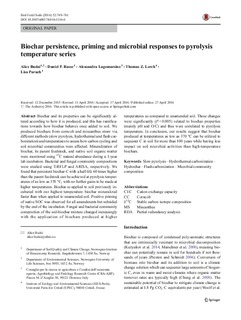| dc.contributor.author | Budai, Alice | |
| dc.contributor.author | Rasse, Daniel | |
| dc.contributor.author | Lagomarsino, Alessandra | |
| dc.contributor.author | Lerch, Thomas Z. | |
| dc.contributor.author | Paruch, Lisa | |
| dc.date.accessioned | 2018-01-02T10:14:23Z | |
| dc.date.available | 2018-01-02T10:14:23Z | |
| dc.date.created | 2016-09-21T11:27:13Z | |
| dc.date.issued | 2016 | |
| dc.identifier.citation | Biology and Fertility of Soils. 2016, 52 (6), 749-761. | nb_NO |
| dc.identifier.issn | 0178-2762 | |
| dc.identifier.uri | http://hdl.handle.net/11250/2473926 | |
| dc.description.abstract | Biochar and its properties can be significantly altered according to how it is produced, and this has ramifications towards how biochar behaves once added to soil. We produced biochars from corncob and miscanthus straw via different methods (slow pyrolysis, hydrothermal and flash carbonization) and temperatures to assess how carbon cycling and soil microbial communities were affected. Mineralization of biochar, its parent feedstock, and native soil organic matter were monitored using 13C natural abundance during a 1-year lab incubation. Bacterial and fungal community compositions were studied using T-RFLP and ARISA, respectively. We found that persistent biochar-C with a half-life 60 times higher than the parent feedstock can be achieved at pyrolysis temperatures of as low as 370 °C, with no further gains to be made at higher temperatures. Biochar re-applied to soil previously incubated with our highest temperature biochar mineralized faster than when applied to unamended soil. Positive priming of native SOC was observed for all amendments but subsided by the end of the incubation. Fungal and bacterial community composition of the soil-biochar mixture changed increasingly with the application of biochars produced at higher temperatures as compared to unamended soil. Those changes were significantly (P < 0.005) related to biochar properties (mainly pH and O/C) and thus were correlated to pyrolysis temperature. In conclusion, our results suggest that biochar produced at temperatures as low as 370 °C can be utilized to sequester C in soil for more than 100 years while having less impact on soil microbial activities than high-temperature biochars. | nb_NO |
| dc.language.iso | eng | nb_NO |
| dc.rights | Attribution-NonCommercial-NoDerivatives 4.0 Internasjonal | * |
| dc.rights.uri | http://creativecommons.org/licenses/by-nc-nd/4.0/deed.no | * |
| dc.title | Biochar persistence, priming and microbial responses to pyrolysis temperature series | nb_NO |
| dc.type | Journal article | nb_NO |
| dc.type | Peer reviewed | nb_NO |
| dc.source.pagenumber | 749-761 | nb_NO |
| dc.source.volume | 52 | nb_NO |
| dc.source.journal | Biology and Fertility of Soils | nb_NO |
| dc.source.issue | 6 | nb_NO |
| dc.identifier.doi | 10.1007/s00374-016-1116-6 | |
| dc.identifier.cristin | 1383660 | |
| cristin.unitcode | 192,1,2,0 | |
| cristin.unitname | Institutt for miljøvitenskap | |
| cristin.ispublished | true | |
| cristin.fulltext | original | |
| cristin.qualitycode | 1 | |

